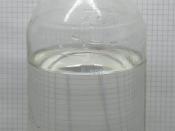In this investigation, I will be studying the factors that affect the rate of reaction. In this case, the reaction between hydrochloric acid and sodium thiosulphate.
Na2S2O3 (aq)+ 2HCl(aq) 2NaCl(aq)+S(s)+SO2(g)
When hydrochloric acid is added to sodium thiosulphate, the chemicals react giving solid sulphur as one of the products. This is a precipitation reaction.
By watching the speed at which the sulphur has formed, we can find out the rate of reaction. A cross can be marked on a piece of paper, and a flask of sodium thiosulphate can be placed on top. By adding hydrochloric acid to the sodium thiosulphate, we can time how long it takes for the view of the cross to become obscured by the sulphur. We can then find out the rate of the reaction.
What is Rate?
Chemical reactions can be seen everywhere, whether an explosion, which is extremely fast, to something very slow, like the rusting of a metal.
It is not enough just to know whether something is fast or slow however. Rate is a measure of the change that happens in a single unit of time. For example, if a car travels 40 km in half an hour, it is travelling at 80 km/h.
For a chemical reaction to take place, some bonds in the reactants must be broken. The colliding particles must have enough energy to break these bonds. This minimum amount of energy is called the activation energy. Only the very fastest moving particles have enough energy to break bonds.
In gases, liquids and in solution, the particles move at a range of speeds. Some are moving very slowly and others are moving very fast. To react, particles must collide with enough energy and in the correct orientation for bonds to be broken.
If there is not...


